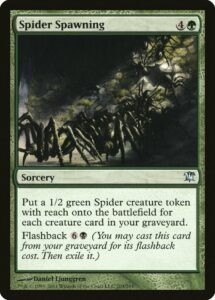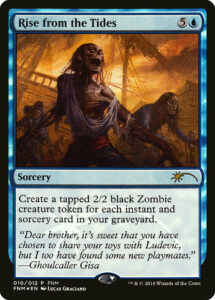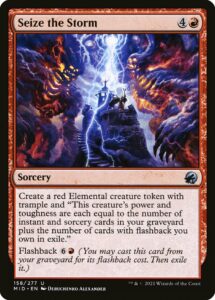With CubeCon a scant two weeks away, I’ve finally had a chance to playtest the UMA-Inspired Cube I’ll be bringing to Madison. It’s a love letter to some of my favorite formats, interactions, and cards of all time. Of all the cards in the cube, Rise from the Tides might well be the one I have the most history with—I have deeply fond memories of playing it in Team Draft League. Heck, I even wrote (to the best of my knowledge) the very first guide to drafting it. So today, let’s take a closer look into its design and execution.

From death, Value
Magic has used the graveyard as a resource ever since Alpha’s Nether Shadow. Nature’s Resurgence demonstrated how one can convert a stocked graveyard into an explosion of resources. Worm Harvest was likely the first card that provided a reliable, recursive engine to overwhelm your opponent over time. These and many other innovations eventually led to cards like Kessig Cagebreakers, Rise from the Tides, Ghoulcaller’s Harvest, and Vilespawn Spider. But you can’t talk about those without discussing Spider Spawning. It wasn’t the first to do what it did, but it made the biggest splash of them all.
Spider Spawning was an astoundingly potent synergy deck. It needed only a few specific cards to function—some self-mill, a decent amount of creatures (regardless of their quality), and at least one copy of the namesake card. You could include a recursive package with Memory’s Journey and Runic Repetition, but you honestly didn’t need it except for style points. The deck took obviously unplayable cards like Gnaw to the Bone and demonstrated that a card which only gains life can be game-winning when it gains you 30+ life, buying time towards a nigh-unbeatable, almost uninteractable combo.
Spider Spawning demanded almost inverted drafting heuristics, where you avoided the “best” cards to hoard draft chaff. It was a secret synergy deck the likes of which would never remain hidden for so long today. It also was unacceptably frustrating to play against, where an army of 1/2 Reach spiders could stonewall anything other than a Rolling Temblor or the even-more-frustrating Invisible Stalker.

Finding the sweet spot
When Wizards returned to Innistrad in 2016, it’s not surprising they did a callback to Spider Spawning. The challenge was to recreate the experience, where an all-in synergy deck could be a viable contender, without recreating the frustration of its inevitability. Rise from the Tides is a weaker spell than Spider Spawning, just as Kroxa, Titan of Death’s Hunger is weaker than Uro, Titan of Nature’s Wrath—one blunts an opponent’s offense and turns the game to your favor, while the other merely provides your own offense.
By having the tokens enter the battlefield tapped (and having no Gnaw to the Bone for massive lifegain), you couldn’t use Rise from the Tides to swing a game from behind—you had to be able to survive one last hit before your army came online. By costing six mana instead of five, your opponent got one more turn to pressure you. By not having Flashback, you might not be able to produce enough power to win the game with a single spell. The loss of Reach further made the zombies worse on defense, but they made up for it in having double the power of spiders on offense. All those nerfs were clearly intended to make Rise less powerful and more interactive than Spider Spawning.
Still, Rise from the Tides was an easier card to enable than Spider Spawning, and that made it a dangerous design. Spiders requires a mix of self-mill and lifegain (which often relies on spells) and creatures, while a Rise from the Tides deck could be entirely comprised of spells and lands. In Constructed, you could feed it with cheap cantrips, then ramp into it with rituals.
The end result proved to be shockingly balanced, where it never made a splash in Constructed and proved potent but manageable in Limited. It’s an incredible feat of design to work with such dangerous tools, following up on a dangerous card, and create something neary perfectly balanced. I love the card not only because of how much fun I had casting it, but because it feels so incredibly fair despite every component of it feeling broken.

As I said at the beginning, I had the joy of playtesting my cube this past weekend. It’s built around four pillars: Madness, spells, artifacts, and the graveyard. Rise from the Tides (along with Spider Spawning) is one of several cards that have two copies in the cube, since they provide essential effects that I want multiple players to have the chance of accessing.
I knew when I put Rise from the Tides into the cube that it wasn’t close to the power level of Spider Spawning—that was obvious from Shadows over Innistrad and even more so from Ultimate Masters (where the two coexisted). But in playtesting, I bore witness to a very strong-looking UR Spells deck that consistently had better things to do with its mana than cast Rise from the Tides.
I may well give Rise’s special duplicate status to Seize the Storm. Seize is more powerful and easier to interact with, since it only makes one large token instead of a massive swarm. Or I may accept that there are simply enough spells-matter payoffs that duplication isn’t necessary, while Spider Spawning remains irreplaceable. Heck, it may well turn out that Rise from the Tides might not even fit into the cube at all, as I might need to substantially lower the power level of everything else for it to be competitive—and I don’t want the power to dip that low.
It’s sad putting a beloved card out to pasture, but that’s part of game design. There’s always another project to give it a home in. And even if the card itself ends up leaving the cube and I never put it in anything else for the rest of time, it still lingers on in in its daughter, Seize the Storm. It was another essential piece of history on the road to a different design that did make the cut. That’s another thing I love about Magic—sometimes, you get to relive great memories of one card by playing with its descendants.
Zachary Barash is a New York City-based game designer and the last commissioner of Team Draft League. He designs for Kingdom Death: Monster, has a Game Design MFA from the NYU Game Center, and does freelance game design. When the stars align, he streams Magic (but the stars align way less often than he’d like).

